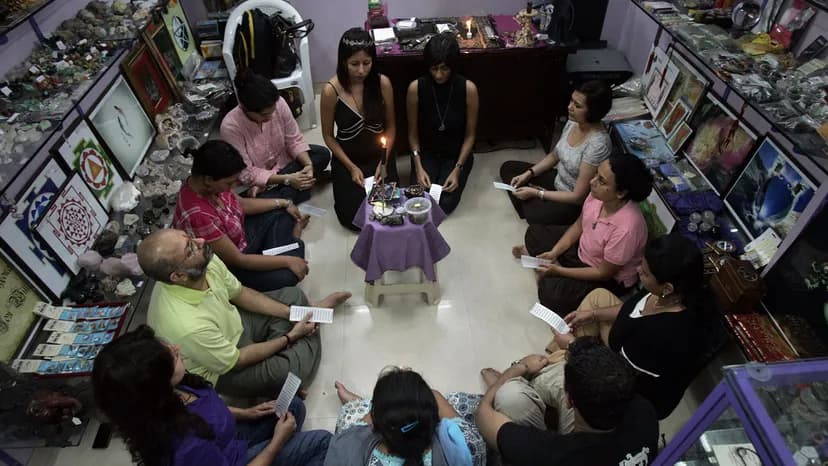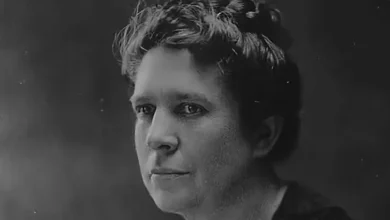Paganism is the oldest and youngest religion

Jussara Gabriel, a Wicca high priestess, and other priestesses pray around a fire during Imbolc, the seasonal Sabbath in honor of Brigid, a Celtic goddess of Irish origin, on August 13, 2020 in Jacarepaguá, Rio de Janeiro, Brazil .
When Christianity went from a persecuted fringe sect to the official religion of the Roman Empire in 415 AD, those in the new monotheistic mainstream hurled an insult at the polytheistic “hillbillies” who still worshiped the pantheon of Roman gods. They called them “pagans,” from the Latin word paganus , which means “country dweller”.
Although most of the rites and practices of pagan belief systems disappeared centuries ago, some modern spiritual seekers have recovered these ancient wisdom traditions and now proudly identify as pagans. By some measures, Modern Paganism is one of the fastest growing religions in America, with about 1 million followers of various pagan sects in the United States. According to the 2014 Pew Religious Landscape Study, 0.3% of Americans identify as “Pagan or Wicca,” which is the same number who identify as Unitarians. In 2008, there were only 340,000 pagans in the US
Modern Paganism (also called Neopaganism, Contemporary Paganism, or just Paganism) is a revival movement encompassing a wide and rich variety of polytheistic religious traditions: Sumerian, Egyptian, Greek, and Roman practices, as well as Wicca (modern witchcraft), Ásatrú the worship of Norse gods, goddesses and earth spirits) and Druidism (an Indo-European priesthood).
With so much diversity in religious traditions and rituals, Modern Paganism defies easy definition. Religious scholar Michael Strmiska has described Modern Paganism as a collection of religious movements “dedicated to reviving the polytheistic, nature-worshipping pagan religions of pre-Christian Europe and adapting them for the use of people in modern societies.”
What modern pagans definitely no They are “historical reenactors,” says Jefferson Calico, professor of religion at the University of the Cumberlands, Kentucky, and author of “Being Viking: Heathenism in Contemporary America.”
“Contemporary Pagans feel a strong connection to the past and look to pre-Christian practices, cultures and spirituality as inspiration for what they are trying to recover, find again or create again,” says Calico. “They look to the pre-Christian traditions of the past as repositories of ancient sacred wisdoms and ways of life that connected us to the cosmos and to each other in ways that are holy and sacred.”
Content
- Pagan Practices and Rituals
- Wicca and women's empowerment
- The rise of paganism
Pagan Practices and Rituals
Unlike Judeo-Christian traditions that center on biblical authority, clergy, and codified belief systems, Modern Paganism is all about ritual. Religious scholar Sabina Magliocco wrote that the role of ritual in Modern Paganism is to achieve communion with nature, with deities, with community, and with the inner self. She describes modern pagan rituals as “communally created forms of artistic expression” that often include drums, dancing, ceremonial fires, incense, and representations of the four elements (earth, air, fire, and water).
Although each modern pagan religion has its own set of rituals, there are some common themes. There are rituals that mark the seasons and cycles of the moon and sun (solstices and equinoxes). There are rituals that honor specific gods or goddesses and nature spirits. There are rituals that celebrate birth, death, marriage and rites of passage. And there are rituals that invoke divine powers to heal, strengthen, and comfort individuals and entire communities.
Most rituals have a three-part structure, according to Magliocco:
- Setting the stage: This may mean symbolically clearing the sacred area or drawing a circle around it.
- Performing the ritual: Communion with the gods through dance, music, guided meditation, etc. within the sacred space.
- Back to reality: Thank and send off the spirits/gods and perhaps share food and drink with the other participants.
In Ásatrú, also known as Paganism or Paganism, one of the most common rituals involves the ceremonial consumption of mead or “honey wine,” one of the oldest alcoholic beverages known to man. In the ritual known as Blot (Old Norse for “sacrifice”), members of the “parenthood” (community) pass a horn filled with mead which is sacrificed to the gods accompanied by prayers to deities such as Odin, Thor and Freya. One Blót can be performed at any time, preferably outdoors, but two of the Blóts The most important events are held on the summer solstice ( Midsummer Blot ) and on the winter solstice ( Yule Blot ).

Although not as common, Magliocco mentions an ancient Egyptian ritual called Navigium Isidis , practiced by the Brotherhood of Isis in Los Angeles. The ancient Egyptians honored the fertility goddess Isis every March, when the Nile flooded its banks and brought life to the valley. Instead of launching boats into the Nile, members of the Brotherhood of Isis make small ice boats (non-polluting) and launch them into the Pacific Ocean carrying their wishes and prayers to the goddess.
You will not find modern pagan “churches” in the sense of a building dedicated to worship. For starters, says Calico, adherents prefer to worship outdoors, where there is a direct connection to the natural world. But there is also the issue of money. Modern Pagans generally avoid asking for tithes, donations, or fees that would go toward building a permanent church or temple.
The only problem with outdoor worship is that Pagans often have to deal with the public, whose reactions can range from curiosity to outright harassment.
“I've been to outdoor events where people yelled rude things at pagans who practiced their religion,” says Calico.
Wicca and women's empowerment
Wicca is one of the largest and oldest religious movements in Modern Paganism. This contemporary revival of witchcraft was first popularized in the United Kingdom in the 1950s with the writings of Gerald Gardner and later caught on in America, especially within the women's empowerment movement of the 1960s and 1970s.
“In the 1970s, women were turning to Wicca and witchcraft, in part because the dominant religion had no place for them in terms of leadership,” says Calico.
Margot Adler, an NPR journalist and Wicca high priestess who wrote the landmark 1979 book, "Drawing the Moon: Witches, Druids, Goddess Worshipers and Other Pagans in America Today," said she was drawn to Wicca and Modern Paganism because the Invoking goddesses appealed to her feminism and the connection to the environment resonated with her love of nature, according to The New York Times. Wiccan author and environmentalist Starhawk has also written popular books about finding inner power through Goddess worship.
In the traditional practice of Wicca, initiates join a coven and are introduced to rituals that prepare them to become priests. Like many other modern pagan religions, there is a magical element to Wicca. Like prayer in other religions, modern Pagans believe that when a ritual is performed with real intent, it can change human consciousness and even reality itself. Wiccans can learn magic (or magic) as part of a coven, or through individual study and practice using books and online resources.
The popularity of modern Wicca and witchcraft has also spread beyond its Anglo-American roots. Brujería , which means witchcraft in Spanish, dates back to pre-Hispanic rituals used in ancient Latin America, Africa, and the Caribbean. The modern ones” Brujas ” (“witches”) in Hispanic and Afro-Caribbean communities have revived traditions such as West African Yoruba and Santería Afro-Cuban people who have been stigmatized by the Christian Church for centuries.

The rise of paganism
In 1972, an Icelander named Sveinbjörn Beinteinsson and some friends decided to revive the public worship of Norse gods, using texts and community rites known as the “Old Way.” This movement, now called Ásatrú or Paganism, spread throughout the world. Other Old Norse religious revivals followed, including Theodism, Urglaawe, Irminism, Odinism, and Vanatru.
In writing his book about Ásatrú in America, Calico visited relatives in the United States, where he estimates there are between 15,000 and 20,000 self-identified Pagans. Ásatrú emphasizes community rituals such as Blot and group study of the “Lore,” a library of Icelandic mythical stories and epics originally written in Old Norse and now widely available in translation. One of the main texts is Hávamál , a poem of traditional wisdom attributed to Odin that is a powerful expression of Old Norse religious philosophy.
As with other modern Pagan religious movements, Pagans exhibit a wide variety of beliefs. Some take a humanistic approach in which Norse gods and goddesses provide useful metaphors or archetypes for making sense of the world. Others are strict reconstructionists who view gods as distinct beings who can be worshiped individually or collectively.
There is a dissident movement within Ásatrú and Paganism that has been co-opted by white nationalists who claim that Old Norse and Anglo-Saxon religions are the exclusive right of Northern Europeans, also known as “white people”. Organizations like the Ásatrú Folk Assembly, which claim that Asatru is tailored to the “unique makeup” of white people, have been labeled “hate groups” by the Southern Poverty Law Center. In response, inclusive Ásatrú organizations like The Troth have advocated for diversity and anti-racism within the religion.
The first Ásatrú temple in 1,000 years is currently being built in Reykjavík, Iceland. The large wooden space is being built on a rocky outcrop traditionally linked to Odin's powers and will host Blots , weddings and community parties.
HowStuffWorks earns a small affiliate commission when you purchase through links on our site.
Now that's cool
Pagan rituals and festivals, like the annual Rites of Spring gathering in Massachusetts, are surprisingly family-friendly, with children's events and workshops and “sacred dances.”





